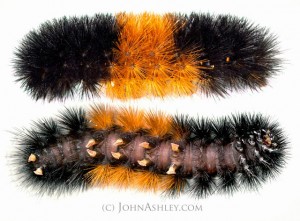Woolly bear caterpillars
Woolly bear Caterpillar Photo credit: JohnAshley.com
The Woolly bear caterpillar is the easily recognized larva of the Isabella Tiger Moth (Pyrrharctia Isabella). In the Fall, the Woolly Bear begins its life as a tiny egg that hatches into a caterpillar. This Woolly bear caterpillar is black at both ends, usually with a reddish orange midsection. This colorful two toned sweater is composed of setae (bristles) radiating away from the body. The bristles form tufts emanating from the 13 segments of the body. The number of black setae increases and the reddish orange central band diminishes as the Woolly bear matures. Folklore that the relative width of these black and reddish copper bands along the Woolly Bear’s body is a predictor of how harsh the winter will be has been disproven. The setae of the Woolly Bear caterpillar do not inject venom or histamine that causes pain or itching, although some people may develop mild dermatitis after handling them. To defend itself, the Woolly bear will role up into a ball when handled. The Woolly bear is a herbivore that feeds on grass, clover, plantain, dandelion, spinach and cabbage.
It can survive the winter because it produces a cryoprotectant to prevent its tissues from being damaged by sub zero temperatures. In the spring it thaws out and grows some more. After enough growth, the caterpillar begins pupation by spinning a cocoon around itself made of silk and its own body hairs. After metamorphosing within the pupa, it emerges in the spring as the Isabella Tiger Moth. The moth’s wings are a muted yellow color with a few scattered black spots. The moth has only a few days to find a mate and lay eggs. The resulting caterpillars will hibernate (freeze) over the winter and renew their life cycle.
To view the Woolly bear caterpillar constructing its cocoon visit
https://www.youtube.com/watch?v=mFDKeMGFPNE

